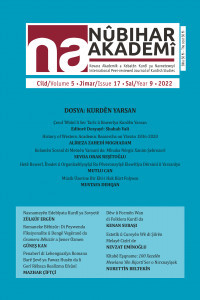Cinema, Horror and the Wrath of God: Turkish Islam’s Claims in the Kurdish East
Cinema, Horror and the Wrath of God: Turkish Islam’s Claims in the Kurdish East
This article offers an allegorical reading of the Turkish horror film Büyü / Spell (Orhan Oguz, 2004). As the first Turkish horror film that takes Islam at the center of its narrative and the first horror film taking place in the Kurdish East, Büyü shifts the ideology of cinematic East away from social realism and the representation of the region as a space to be modernized in accordance with the Kemalist national modernization process. Unlike the East in social realism where feudalism, Islam and illiteracy were seen as main problems to be dealt with, Büyü’s main concern over the East is its diversion from Islam and the threat the influx of non-Muslims poses to the Turco-Islamic unity the region is shown to enjoy in a remote past. In Büyü, the Kurdish East is represented as the space of horror, death, and sorcery, and Islam is offered to fight the horror. The article studies the film as an early example of popular culture in Turkey where one can trace the national and territorial ideology of the new pro-Islamic Justice and Development Party, which during the early 2000s was in search of hegemony against not only the secularist Turkish political elite but also the Pro-Kurdish political movement in the Kurdish East.
Keywords:
horror film, Turkish Cinema, social realism allegory,
___
- Adivar, H. E. (2007) Vurun Kahpeye. Istanbul: Can.
- Akekmekci, T. (2010). Dogu Sorunu: Necmeddin Sahir Silan Raporlari. Istanbul: Tarih Vakfi.
- Besikçi, I. (1992). Dogu Anadolu’nun Düzeni. Ankara: Yurt.
- Bozarslan, M. E. (2005). Dogu’nun Sorunlari. Istanbul: Avesta.
- Dowling, W. C. (1984). Jameson, Althusser, Marx: an introduction to The political unconscious. Ithaca: Cornell University Press.
- Ergil, D. (2009). Kürt Raporu: Güvenlik Politikalarından Kimlik Siyasetine. Istanbul: Timas.
- Jameson, F. (1981). The Political Unconscious: Narrative as a Socially Symbolic Act. Ithaca, N.Y.: Cornell University Press.
- Jameson, F. (2020). Allegory and Ideology. New York: Verso.
- Jorgensen, J. (2007). The Settlement Issue in Turkey and the Kurds: An Analysis of Spatial Policies, Modernity and War. Leiden: Brill.
- Karaosmanoglu, Y. K. (1983). Yaban. Ankara: Iletisim.
- Lowenstein, A. (2005). Shocking Representation: Historical Trauma, National Cinema, and the Modern Horror Film. New York: Columbia University Press.
- Newman, K. and BFI (1996). The BFI Companion to Horror. London: Cassell.
- Prince, S. (2004). The Horror Film. New Brunswick, N.J.: Rutgers University Press.
- Schneider, S. J. (2004). Horror Film and Psychoanalysis: Freud's Worst Nightmare. New York: Cambridge University Press.
- Sen, S (2019). Gemideki Hayalet. Istanbul: Metis.
- Yegen, M. (1999). Devlet Söyleminde Kürt Sorunu. Ankara: Iletisim.
- Yücel, M. (2008) Türk Sinemasında Kürtler. Istanbul: Agora.
- ISSN: 2147-883X
- Yayın Aralığı: Yılda 2 Sayı
- Başlangıç: 2014
- Yayıncı: PAK AJANS Yayıncılık
Sayıdaki Diğer Makaleler
101 Issue of the Journal of Kurdistan for First Time
An Evaluatîon on Kurdish Grammar Books in Terms of Grammar Teaching Methodologies
An Overview of the Content of the Heyranoks of Van Region
Cinema, Horror and the Wrath of God: Turkish Islam’s Claims in the Kurdish East
